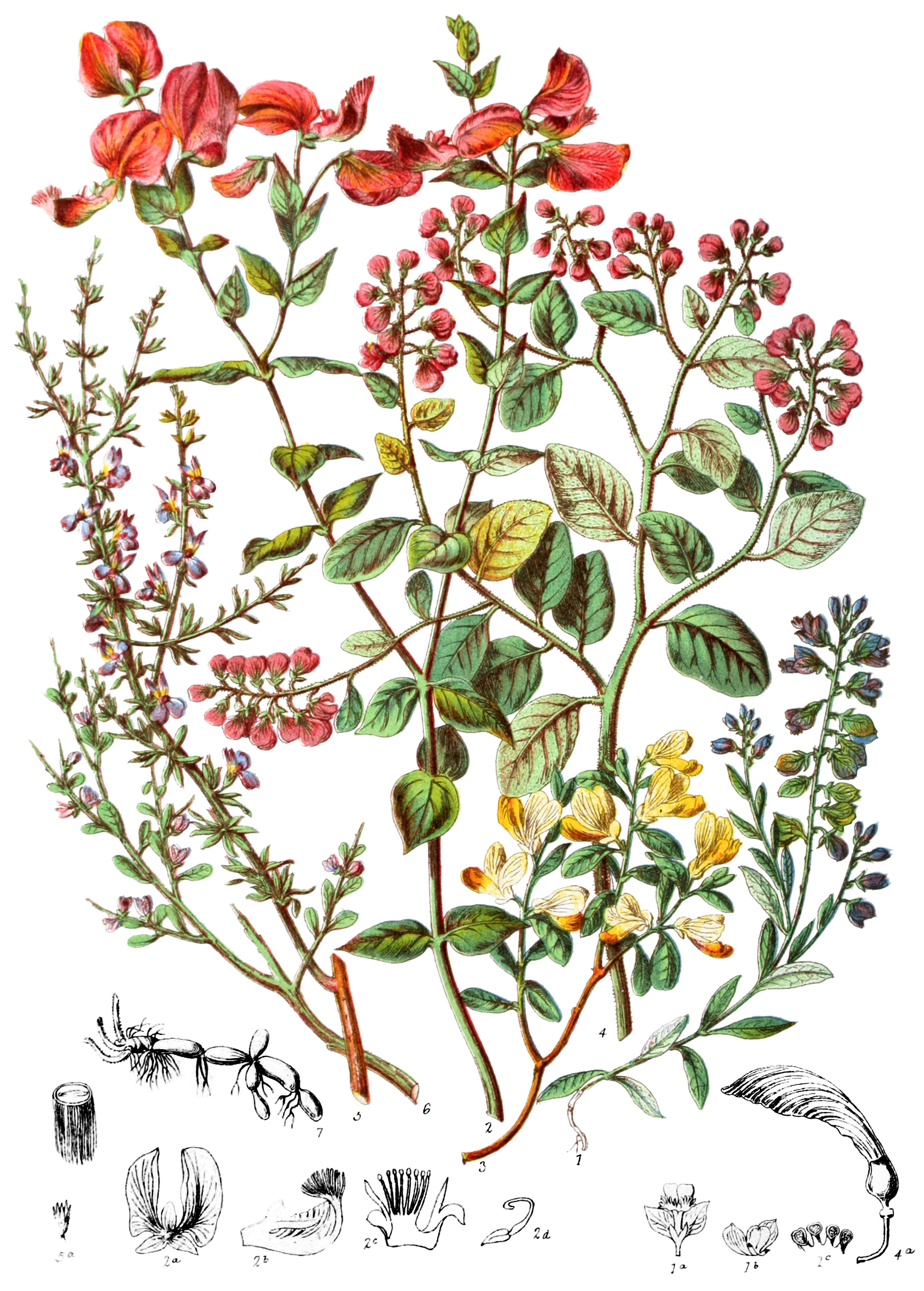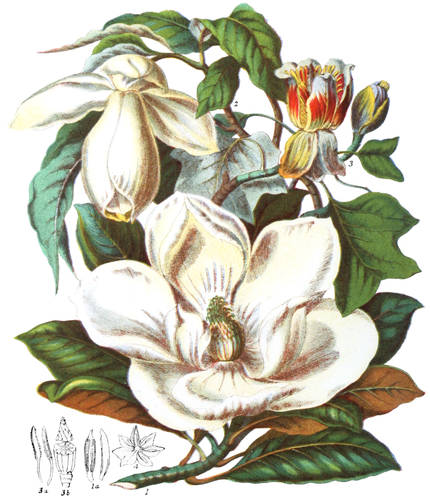Key characteristics
Trees, shrubs, and herbaceous plants, some of which are twiners. The leaves are generally alternate, sometimes opposite, mostly simple, and always without stipules. The flowers are usually on branching stalks, often small and inconspicuous, but in some instances showy. The flower-stalks have small bracts. The sepals of the calyx are five, very irregular, distince; the two inner side sepals are usually large, of the colour of the petals, and form the wings of the flower. The petals are commonly three, one of which is larger than the rest, and is the keel; sometimes they are five, two minute petals being placed at the sides; the keel is either entire at the edge and bare or crested at the back, or it is divided into three lobes at the edge, and destitute of a crest. The stamens are unequal, usually eight, combined in a tube which is split opposite the upper sepal; sometimes four and distinct. The anthers are club-shaped, mostly one-celled, and opening at the point. The ovary is above the base of the flower, compressed, with two or three cells; the style is simple curved, entire, or lobed; sometimes very oblique and hooded at the top; the stigma simple. The fruit usually opens through the valves, occasionally closed, membranous, fleshy, leathery, or drupaceous, winged or not. The seeds are pendulous, naked, or clothed with hairs; the outer covering crustaceous, the inner membranous; albumen abundant fleshy.
The hooded stigma connects these flowers with Violets; in the form of corolla there is a resemblance to the Pea tribe, but in structure and properties there is most affinity to the Sapindaceæ.
Milky roots and intense bitterness are the prevailing qualities of this Tribe.
Select plants in this order
Not all plants listed are illustrated and not all plants illustrated are listed.
- Polygala vulgaris (1) is one of the most curiously constructed of our native flowers. It is frequent on gravelly, healthy pastures, and is worthy of minute examination. The two enlarged side sepals are of a blue colour, like the petals, and forming wings to the corolla, give it the appearance of a papilionaceous flower; as the seed-vessel ripens, the two large portions of the calyx lose the blue tint, and become green like the rest, remaining folded at the sides of the heart-shaped pod. The lower petal is keel-shaped, having a crest at the back resembling the fringed white.
- P. amara is extremely bitter in its juices: occasionally found in this country; abundant in the turfy, moist meadows of Switzerland.
- P. chamæbuxus (3) is one of the eight species of Germany and the Alps: a yellow flower amidst the prevailing purple or blue colour of this tribe.
- P. cordifolia (2), and P. speciosa, are amongst the most beautiful species; many are small and of insignificant aspect; some have heath-like leaves, with minute flowers growing in spikes or clusters. Upwards of 160 species are known to exist in different countries; about fifty are natives of fields or pastures in Brazil.
- P. paludosa is a slender little plant, inhabiting marshes;
- P. hispida is densely clothed with hairs.
- P. senega possesses strong pungent qualities in the contorted woody root—considered by the American Indians as a remedy for the bite of the rattlesnake.
- Several others are reputed to have valuable medicinal properties: in P. venenosa emetic principles exist so powerfully, that the natives of Java dread it as a poison.
- Thirty kinds belong to India; some have been found on the Khasya and Bhootan mountains at an elevation of 6000 feet; nine grow on the Himalayas, the root of P. crotolarioides (7) is there employed against the bite of venomous reptiles, with the same success as the American Snake-root; P. tinctoria affords a dye in Arabia.
- Securidaca (4) is so called from the hatchet-shape of the seed-vessel—the wing extending in a curved form.
- The leaves of these species vary much; those of S. nitida are large and shining; S. volubilis has a strong, woody, climbing stem, bearing abundant seed-vessels.
- Muraltia (5), called after a Swiss botanist of the last century, is a genus of neat foliage and small flowers; M. ciliaris is covered with extremely minute horizontal hairs.
- Mundia spinosa (6) bears an eatable fruit of the drupe kind at the Cape.
- The bark of the roots of Monnina is pounded into balls, and used as soap in Peru; and the celebrated silver-work of Huanuco is polished by it.
- Trigonia (8)* is an example of the seed having long hairs;
- T. macrocarpa, on the Esequibo, has capsules three inches long.
- Xanthophyllum yields wood of value.
- Although nearly all the plants of this Tribe are bitter, Soulamea amara, of the Moluccas, is most intensely so, and is employed as a remedy in fever throughout the Malayan Archipelago.
Locations
Most of the plants of this Tribe are limited to one or two of the great portions of the globe; but Polygala occurs in Europe, Asia, Africa, and America, very unequally distributed, inhabiting every description of situation—plains, mountains, woods, morasses, cultivated or barren ground, in the tropics and in temperate climates. Muraltia belongs to South Africa, Salomonia to Asia, Monnina to South America, Soulamea to India and China, Comesperma to Brazil and Australia.
Legend
- Polygala vulgaris, Common Milkwort. England.
- Flower.
- Seed-vessel and Calyx.
- Polygala cordifolia, Heart-leaved Polygala. Cape of Good Hope.
- Calyx.
- Crested Petal.
- Stamens and Petals.
- Pistil.
- Polygala chamæbuxus, Box-leaved Polygala. Switzerland.
- Securidaca tomentosa, Woolly-leaved Securidaca. Meadows, Brazil.
- Seed-vessel of S. erecta.
- Muraltia mixta, Heath-leaved Muraltia. Cape of Good Hope.
- Calyx.
- Mundia spinosa, Spiny Mundia. Cape of Good Hope.
- Root of Polygala crotolarioides. Himalayas.
- Seed of Trigonia.*
- *8 was not picutred in original illustration
- †1c was not named in the original description.
- ‡A stem-like illustration was not labeled in original illustration or named in the original description.
Explore more
Posters
Decorate your walls with colorful detailed posters based on Elizabeth Twining’s beautiful two-volume set from 1868.
Puzzles
Challenge yourself or someone else to assemble a puzzle of all 160 botanical illustrations.





